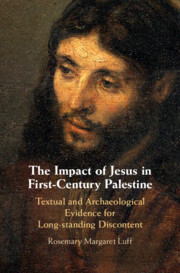 The Impact of Jesus in First-Century Palestine
The Impact of Jesus in First-Century Palestine Book contents
- The Impact of Jesus in First-Century Palestine
- The Impact of Jesus in First-Century Palestine
- Copyright page
- Dedication
- Contents
- Illustrations
- Preface
- Introduction
- Part I Memories of Jesus: The Textual Evidence
- Part II Jesus in Context: The Archaeological Evidence
- 4 Jewish Identities and the Distribution of Ethnic Indicators
- 5 Health Hazards in First-Century Palestine
- 6 Status, Power, and Wealth
- Conclusion
- Bibliography
- Index
4 - Jewish Identities and the Distribution of Ethnic Indicators
from Part II - Jesus in Context: The Archaeological Evidence
Published online by Cambridge University Press: 26 July 2019
- The Impact of Jesus in First-Century Palestine
- The Impact of Jesus in First-Century Palestine
- Copyright page
- Dedication
- Contents
- Illustrations
- Preface
- Introduction
- Part I Memories of Jesus: The Textual Evidence
- Part II Jesus in Context: The Archaeological Evidence
- 4 Jewish Identities and the Distribution of Ethnic Indicators
- 5 Health Hazards in First-Century Palestine
- 6 Status, Power, and Wealth
- Conclusion
- Bibliography
- Index
Summary
This chapter explores socio-economic versus halachic explanations for the distribution of ethnic indicators between Judea and Galilee. Fewer miqwa’ot and scant ossuaries have been found in Galilee. Regarding ossuaries, the trickle-down effect from the Judean elite, who had adopted this Roman mode of burial, to the Galilean elite, would have taken time and resulted in smaller and more modest adjustments; this could partially account for any ossuary disparity between Galilee and Judea pre-70 CE. But, more importantly, the difficulties in distinguishing between first-century and second-century Galilean tombs have hampered firm conclusions being made. The miqwa’ot data demonstrate a difference in the interpretation of the Halacha (religious rules), that reflects a diverse Judaism firmly underpinned by a common Judaism identified through a number of archaeological artefacts, such as the Herodian or knife-pared oil lamp common in both Galilee and Judea. The widespread presence of pig bones on Jewish sites, albeit in low numbers, also demonstrates a diverse Judaism. Stone vessels were discovered on all types of site across Judea and Galilee and, with the exception of large jars clearly produced for the wealthy, were used by all classes. This stone vessel revolution has been interpreted as establishing Jewish identity and self-sufficiency.
Keywords
- Type
- Chapter
- Information
- The Impact of Jesus in First-Century PalestineTextual and Archaeological Evidence for Long-standing Discontent, pp. 77 - 113Publisher: Cambridge University PressPrint publication year: 2019


